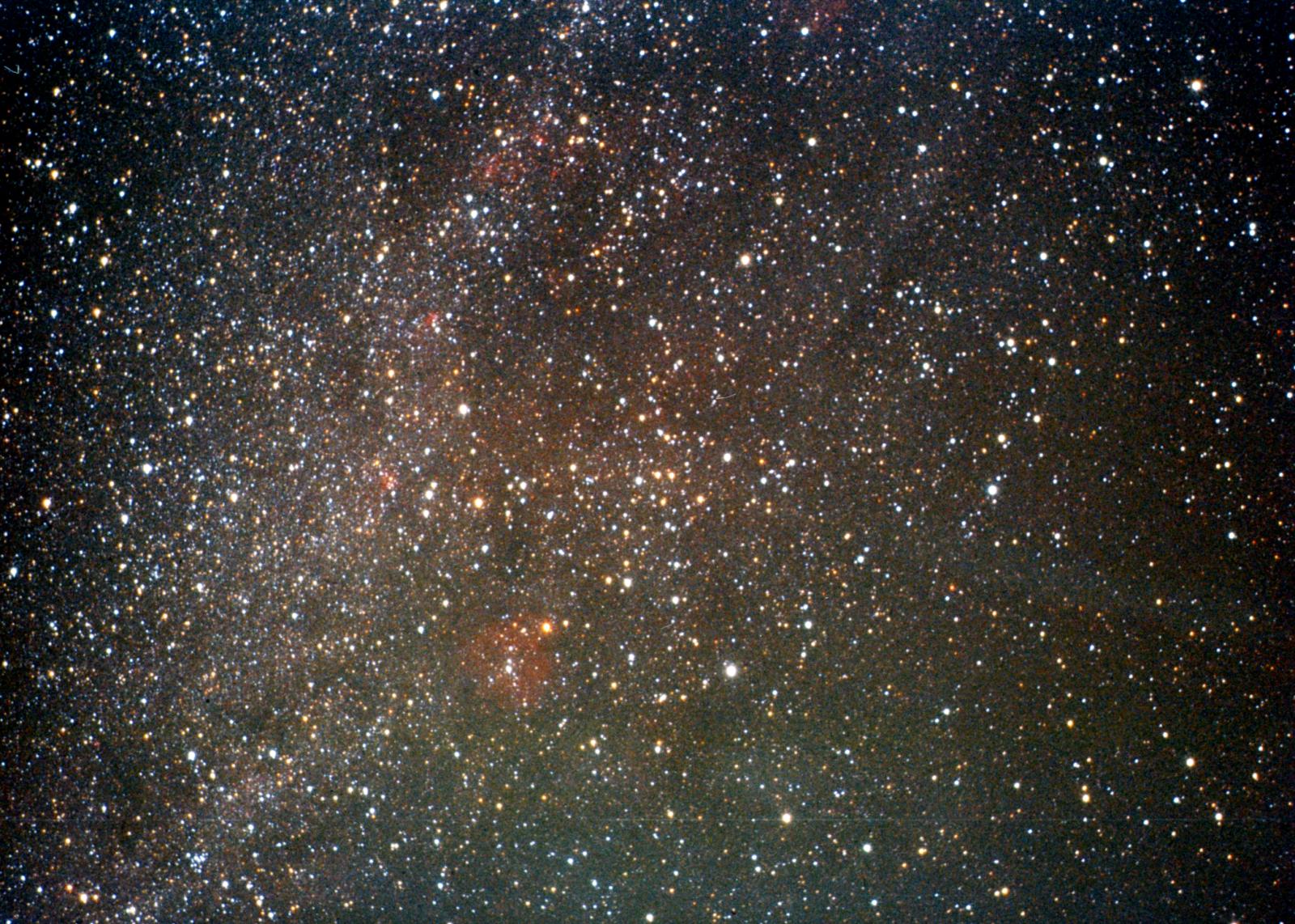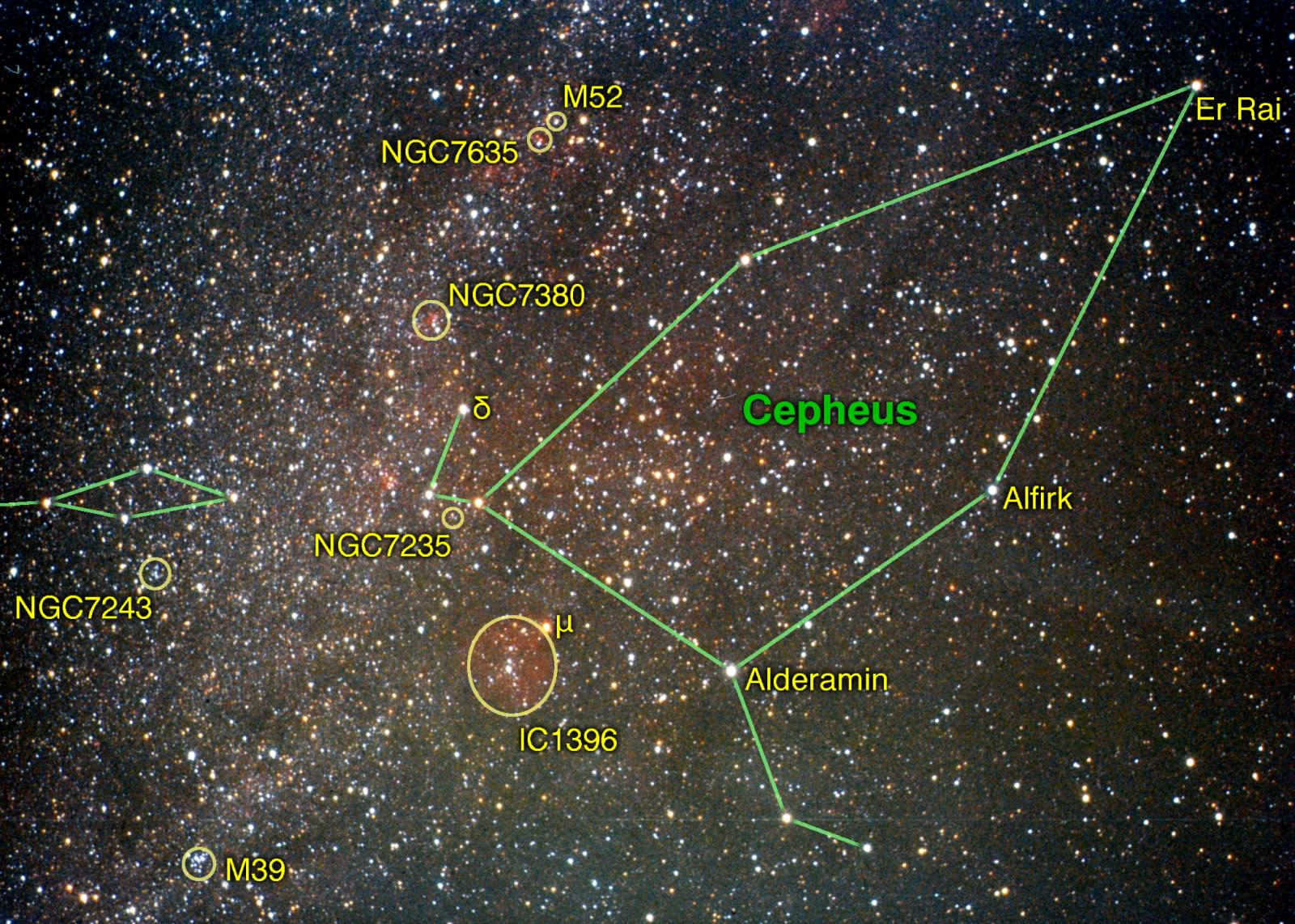Cepheus: The King
| Object: | Cepheus |
| Location: | Narrowsburg, NY |
| Observer: | Roland Roberts |
| Time: | 10 Oct 2001 |
| Camera: | Pentax A3000, 50 mm f/2 lens |
| Film: | Kodak Elite Chrome II, ISO 200 |
| Exposure: | 11 minutes at f/4 |
Not far from Cassiopeia lies Cepheus.
This was taken in mid-October of 2001 the same night I took a shot of Cassiopeia. This exposure was cut a little shorter than I had intended due to fog rolling in rather suddenly. Still, it came out reasonably well. Click on the image for a larger version.
The constellation Cepheus is often described as a house shape (turn your head on its right side and squint). None of the stars in Cepheus are as extremely bright, and with it being so close to the Milky Way, it’s not hard to miss it when you first go looking (well, I had a hard time finding it). Peaking into the picture at the left is the head of Lacerta, the Lizard and the upper left corner of this picture actually belongs to Cassiopeia.
Labeled in both of these pictures are the following objects:
- Open Clusters (6): M52 (NGC 7654 which is really in Cassiopeia), NGC 7380, NGC 7243 (which is really in Lacerta), IC 1396, M39 (which is actually in Cygnus), and NGC 7235.
- Emission Nebulae (1): NGC 7635
- Stars (5): α (alpha) – Alderamin, β (beta) – Alfirk, γ (gamma) – Er Rai, δ (delta) and μ (mu) Cephei.
ξ (Xi) Cepheus, also known as Kurdah, is not shown on the overlay.
Delta Cephei has no name, but does have a reputation. This is the prototypical Cepheid variable whose regular brightness fluctuations were first discovered by John Goodricke in 1784 [1].
Mu Cephei has a not so well-known name of Erakis and is perhaps better known as William Herschel’s “Garnet Star.” It is among the most (if not the most) red stars visible to the naked eye from the northern hemisphere. It is nestled up against the edge of IC 1396 and is, in fact, partially obscured by it which also contributes to its redness.
Resources:
[1] Burnham, Robert Jr., Burnham’s Celestial Handbook, vol. 1, Dover Publications, 1978, p.583.
Search
.Archives
- May 2025 (3)
- October 2024 (1)
- May 2024 (2)
- April 2024 (3)
- September 2022 (5)
- April 2022 (1)
- January 2022 (3)
- December 2021 (4)
- September 2021 (3)
- July 2021 (1)
- January 2021 (1)
- November 2020 (2)
- October 2020 (2)
- September 2020 (2)
- August 2020 (5)
- July 2020 (1)
- November 2019 (2)
- September 2019 (1)
- August 2019 (2)
- September 2017 (1)
- August 2017 (1)
- September 2015 (3)
- August 2015 (2)
- June 2015 (5)
- May 2015 (3)
- May 2013 (2)
- January 2013 (1)
- December 2012 (2)
- September 2012 (1)
- June 2012 (1)
- May 2012 (1)
- October 2011 (2)
- September 2011 (2)
- April 2011 (2)
- March 2011 (10)
- January 2011 (8)
- November 2010 (2)
- October 2010 (1)
- September 2010 (3)
- August 2010 (2)
- July 2010 (1)
- June 2010 (1)
- April 2010 (3)
- February 2010 (3)
- January 2010 (3)
- December 2009 (6)
- November 2009 (3)
- October 2009 (7)
- September 2009 (8)
- August 2009 (4)
- July 2009 (1)
- June 2009 (2)
- May 2009 (2)
- April 2009 (7)
- March 2009 (1)
- February 2009 (6)
- January 2009 (4)
- December 2008 (4)
- November 2008 (3)
- October 2008 (11)
- September 2008 (4)
- August 2008 (5)
- July 2008 (5)
- June 2008 (2)
- April 2008 (4)
- March 2008 (18)
- February 2008 (9)
- November 2007 (1)
- October 2007 (3)
- July 2007 (3)
- April 2007 (1)
- March 2007 (6)
- February 2007 (3)
- December 2006 (3)
- October 2006 (4)
- September 2006 (1)
- July 2006 (5)
- May 2006 (10)
- April 2006 (9)


